By Peter Hossli (text) and Robert Huber (photos)

This 74-year old petite woman, with white curls and gold earrings, should know. She worked for thirty years at General Motors, the largest car manufacturer in the USA. Erin Priest produced parts for Buicks as well as Chevys in Anderson. She has tested all the GM models. Once a year she would buy herself a new car, because she loved the “unused scent” of the interior so much and could afford this nasal feast, “GM paid very well and granted us considerable reductions.”
In the past few years Priest has held back a bit, she’s still driving a Buick from 1997. Instead of buying she’s just been eyeing the showrooms. Now she’s ready to choose again and of course, it will be from GM. She’s loyal because of the rebates but also says Priest, “Because General Motors secures my retirement.” And not just hers, but that of an entire town in America’s Midwest. Over 10,000 GM-retirees live in Anderson. Their pensions are the most important source of revenue for the dwindling town.
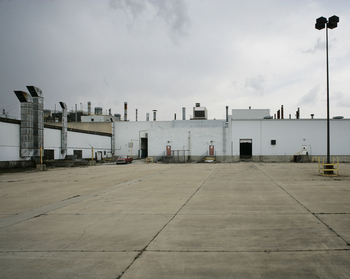
For decades the auto giant provided three-quarters of Anderson’s economy. Today – the company moved out completely in 1999 – GM is still the major revenue provider. Its merry pensioners, after 30 years on the assembly lines at General Motors, receive health benefits, as well as generous pensions. But because of this outdated welfare state, GM is lurching on the verge of bankruptcy. Their portion of the US auto market has dropped from 50 percent to 25 percent. Only 141,000 employees are left today but are responsible for generating enough profit to cover the retirement of 463,000 pensioners. The GM Pensions Fund costs 6 billion dollars a year.
Money that is keeping the city going. While the population has reduced from almost eighty thousand to below sixty thousand, the healthy, affluent seniors who are left can indulge themselves with their GM pensions like the good old times. “This city belongs to us, we have the say here”, says Erin Priest proudly. Then she explains wistfully what will happen when their gone. “Once we retirees are gone, Anderson will become a ghost town.”
But for now, the senior citizens are spending their money. They buy cars and shop at Mounds Mall, the rundown shopping centre on Scatterfields Road built especially for factory employees. Their taxes keep the city water and electricity running. On Saturdays they bet on the horse races and during the week they gamble at cards and bingo.
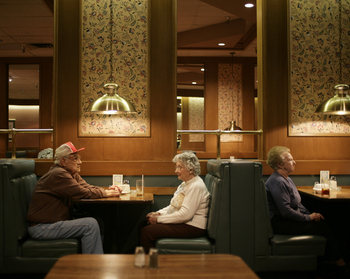
Every Monday evening, Elisabeth Cobble bowls with 80 other seniors at the Cooper’s Bowling Alley, a classic bowling alley built during the GM-boom. At least sixty of the grey or bald bowlers were once at General Motors, estimates Cobble. The floors are shiny with wax, the tables are bright orange and the chairs are red. Only those wearing rubber-soled shoes are allowed on the lanes. With immense verve, Cobble propels the heavy synthetic ball forwards, no sign of arthritis. Two pins are left standing. “GM took good care of us and still does”, says Cobble, who worked as an inspector for 38 years. She bowls “because of the wonderful people” that she met at the factory. When GM left, she cried.
Bill Pitts has little time for tears. He stands behind the counter at Lemon Drops, a lemon yellow painted diner from the Fifties. Balanced in each hand are two plates filled with fries and juicy hamburgers that he serves in one of the upholstered booths. Time seems to have stood still here; the nostalgic ambiance is reminiscent of an Edward Hopper painting. Outside a neon sign blinks while inside the chrome barstools shine in the dim yellow light. Oil is seething in the deep fat fryer. The cold ginger ale is served in soda glasses with lots of ice.
Pitts took over the Lemon Drop in 1972, the oil crisis happened just after. Japanese compact cars invaded the US market and pushed the thirsty American gas-guzzlers out. GM closed their first plants. It wasn’t bad for his business though. “Before the workers used to come to me, now they come as pensioners,” says Pitts, who wears a short white apron tied around his hips.

They come here out of habit. And because they like to daydream about the past, says Ferguson, who joined GM in 1941. The Detroit firm, once the world’s largest, employed her entire family back then. Three brothers and three sisters all slaved for GM, their mother and father as well. She herself had no children – and is glad about it. “They would have had to leave otherwise.”
There are hardly any jobs left in Anderson that pay more than ten dollars an hour. By comparison, a GM employee earns around 35 dollars. But while there were once ten thousand such jobs, now young people have to work at McDonald’s or Wal-Mart who often pay only the minimum wage.
That’s a lot less than what Flo Ferguson receives. GM sends her a monthly check for over 1500 dollars, and on top of that she receives around 600 dollars from Social Security. GM also cover all doctor and hospital expenses as well. Her house was paid off a long time ago. So one can live well in Anderson, where a hamburger costs $1.51 at the Lemon Drop – at least until the last pensioner is gone.
That’s a day that owner Bill Pitts fears. “My hair is grey. When the pensioners are gone, I won’t be here either.” And Anderson? “It will disappear from the map.”
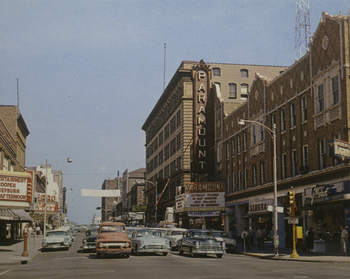
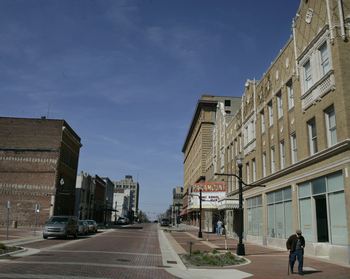
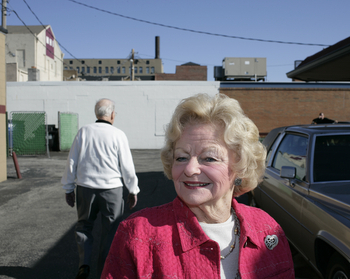
However, she does know what made the city that once crowned her, blossom. “Anderson is never coming back.” At the next table, Eugene Yates, 84, lifts a dark pair of sunglasses from his eyes and agrees. The bald-headed banker managed and loaned money in Anderson for fifty years. He saw the good times “it was boom, boom, boom” – and the bad times. Supposedly, the town is waiting for the turnaround. House prices have risen dramatically, but those who work at McDonald’s can’t afford a mortgage. Many will leave because of this. “We need quite a few factories to fill the hole left by GM. It’s not going to happen. Anderson will soon become just a sleeping town.” This is a fate that awaits many US towns in the next years that still have GM factories. At the beginning of the year General Motors announced that they were laying off a further 30,000 employees.
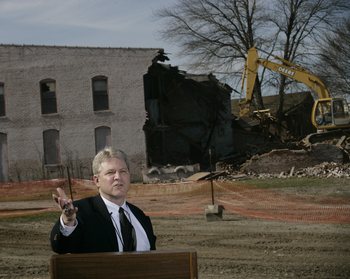
Standing in front of an old factory in the middle of town, Smith protrudes his fleshy face toward the flashing cameras. The much-too-high podium reaches his chest. He raises his left thumb for a handful of local reporters. This is the signal for the digger driver to tear down the faded rose-coloured brick wall of the former sawmill. “This is a beginning, not an end”, Smith speaks in clichés in to the microphone. “We’re making room for new factories.”
He’s searching for them worldwide. He wants to travel to China, he was already in Israel and Japan, where he promised tax benefits and praised the merits of his town, its central location and the many former GM engineers. There are newly paved streets, fibre optic cabling giving Anderson a rapid connection to the Internet and flower boxes on the bridges.
The only thing missing are new jobs. The glass industrial park on the outskirts of town that has been run for the last year by an ex-GM Manager has not brought in a single innovative company. Despite this, Smith is full of confidence. “Look at the traffic here.” He points to a busy side street filled with snack bars. “Commerce – that’s our potential.” He only begins to falter when asked when he thinks the comeback will happen. ”Of course no one can say for sure, it doesn’t happen overnight.”
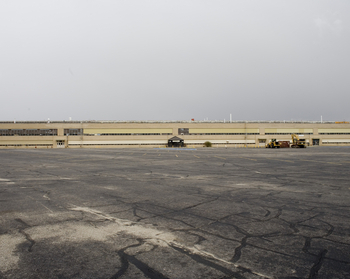
Tightly knit barbed wire fences in the land of the future. All 80 hectares are contaminated industrial fallow land. Growing there are a few weeds, the rest is cemented over. Embedded underneath are tons of chemical and oil residues that GM let seep away. Landowners General Motors are obligated to decontaminate the land, says the mayor. An expensive obligation that General Motors, who lost 10.6 billion dollars last year, would like to postpone as long as possible. GM has still not acknowledged responsibility for the purported environmental problem. And a disaster for Anderson should GM declare bankruptcy as many analysts predict. “Then the contamination and our turnaround would be delayed years, if not decades”, Smith admits frankly. Not only that. The land tax that GM still pays would dry up. The retiree’s pensions could either be reduced or discontinued.
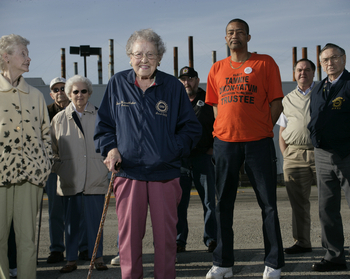
The oldest is the most outspoken. “Greed and Washington have destroyed us”, says Iva Hazelbaker. She is 97 years old. Proudly she wears the blue windbreaker with the Union’s logo. Her eyes are alert and her mind is sharp. With her cane she moves briskly and stands erect. “I’m healthy because GM gave me good jobs”, she says and then corrects herself. “We had to fight for everything.”
The most important line in her contract states she has a right to a monthly pension for “the rest of her life” based on her last salary. “As long as I receive this, things are good with me”, says Hazelbacker, “but only for that long.” This statement subdues the pensioners. All are afraid the car giant will try to go to bankruptcy court to cut their pensions. “Bankruptcy would make little sense for GM”, says company spokesperson John McDonald by e-mail. Hazelbaker doesn’t believe him. The senior citizens blame the politicians who tore down the trade barriers and the GM managers who exported jobs to lower wage countries. The mayor’s plans are rubbished. He’s “a scoundrel that acts important and produces a lot of hot air”, says Hazelbaker. “The high-tech jobs are going to India, they’re not coming to Anderson.” No one should be surprised that GM sells fewer cars today. “The company took work away from their own customers”, she says. The only people left in Anderson are pensioners and their children, who still buy General Motors. They bring in 90 percent of his business, says a Chevrolet dealer.
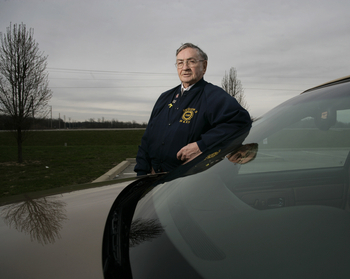

The technological is looking more and more like one of those ‘sounded like a good idea at the time’ kind of things. Thus, the inheritance of our age; entrapment within a great industrial machine with an insaitable hunger for energy, and producing a sludge of material that is unknown in nature. It is a shame that towns like Anderson have so much of their rich Indiana soil poisoned by the waste of an industry that had been condemned as an evil. I suppose hindsight is 20/20. I plan on visiting Anderson. Mayby it could be turned into turist trap, a mecca of sorts for those who are gm fanatics. “Visit Anderson, GM’s Model Company Town”.